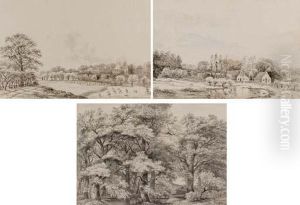Engelbertus Matthias Engelberts Paintings
Engelbertus Matthias Engelberts was a Dutch painter born in 1775 in Amsterdam, Netherlands. He emerged during a period of art that was characterized by a shift from Rococo to Neoclassicism and Romanticism, placing him at an interesting crossroads of artistic movements. Despite the rich artistic milieu of the era, detailed records of Engelberts' early life and training are scarce, a common issue for many artists of his time. However, it is known that he was active in the late 18th and early 19th centuries, a period that was ripe with artistic evolution in Europe, particularly in the Netherlands, which had a long-standing tradition of producing master painters.
Engelberts is primarily known for his landscape paintings, which captured the serene and picturesque Dutch countryside with a remarkable attention to detail and a subtle, yet effective use of light. His works often reflect the tranquility and beauty of the Netherlands' landscapes, incorporating elements of both the Neoclassical clarity and order and the Romantic emphasis on emotion and the sublime in nature. Though not as widely recognized as some of his contemporaries, Engelberts contributed to the Dutch painting tradition by continuing its focus on landscapes, a genre deeply rooted in Dutch identity.
Throughout his career, Engelberts remained relatively localized in terms of his influence and recognition, with most of his works staying within Dutch borders. This limited exposure outside the Netherlands has contributed to his somewhat obscure status in the broader context of European art history. Despite this, his paintings are appreciated for their technical skill and emotive qualities, showcasing his ability to capture the essence of the Dutch landscape with a sensitive and refined touch.
Engelbertus Matthias Engelberts passed away in 1842, leaving behind a modest but significant body of work that contributes to our understanding of Dutch landscape painting during a pivotal time in art history. While comprehensive studies on his life and oeuvre are limited, the paintings he left behind offer a glimpse into the rich artistic culture of the Netherlands and the enduring appeal of its landscapes. Engelberts’ legacy, like that of many artists of his time, is preserved in the collections of Dutch museums and in the appreciation of art historians and enthusiasts who recognize the value of his contribution to the Dutch artistic tradition.
